Imagine being able to send a Christmas card electronically. Sounds crazy futuristic, right? Well that’s what this Sunday newspaper comic promised to the good people of 1960. Though it was a bit more complicated than the e-cards and emails we send today.
The December 25, 1960 edition of Arthur Radebaugh’s “Closer Than We Think” showed how a Christmas card of the future might make its way from Boston to Hawaii — all in just a matter of minutes!
But when you break it down, the entire process doesn’t sound quite so easy. First, you’d have to write out a Christmas card and drop it in an old fashioned mailbox. Then, once it gets to the post office, postal workers would scan it and send a facsimile of the card to either a USPS satellite or bounce it off the moon. The signal is then picked up at a post office near its destination and reproduced in microfilm form and hand delivered to the recipient in a “capsule.”
From “Closer Than We Think”:
Christmas cards of the future may be transmitted electronically. The post office is studying the use of space technology for quick movement of endless quantities of mail between widely separated points.
To do this, microwave stations would be set up. Envelopes would be opened mechanically, and automatic “fingers” would remove the contents and expose them to a scanner. Impulses from the card or letter might be beamed to a postal satellite or even the moon, bounced back to the destination point, reproduced there in the original printing or handwriting, sealed in a capsule and delivered. All this might be done minutes from the time the communication first arrived at a post office thousands of miles away.
There were just a tiny handful of satellites in orbit when this comic ran in American newspapers in 1960. And obviously, electronic mail wouldn’t actually become mainstream for many decades to come. But even though it looks a bit different than what was predicted, this vision from 1960 was essentially correct.
The one thing they didn’t foresee? That the US Postal Service would be totally written out of the equation.
Image: Scanned from the December 25, 1960 Chicago Tribune
